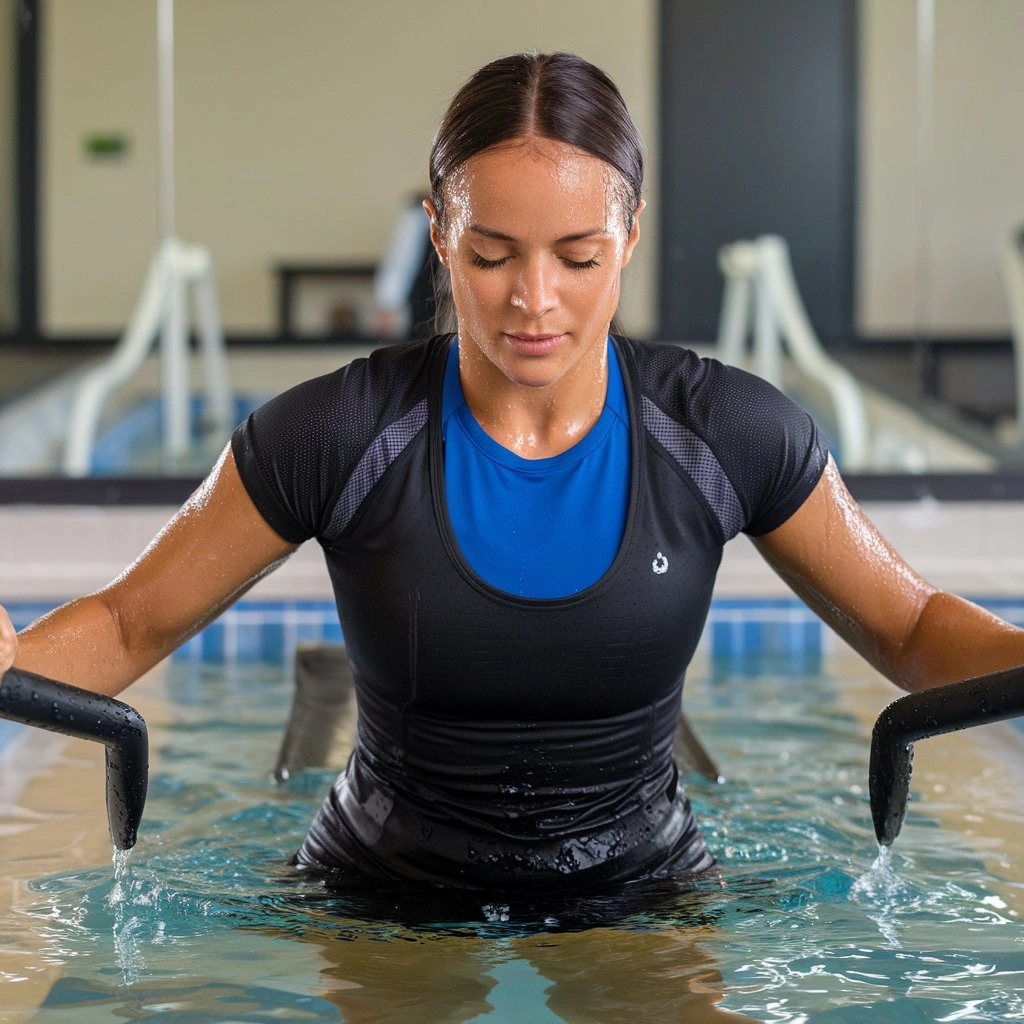Water treadmills are revolutionary fitness and rehab tools. They offer a blend of gentle exercise and healing. The machines are innovative. They use the properties of water to provide a challenging but gentle workout.
This makes them suitable for people of all fitness levels and ages. They were originally developed for rehab. But, they have become popular in fitness centers, sports facilities, and home gyms. This is because they are versatile and effective.
Regular treadmills can be tough on knees and muscles. Water treadmills are different. They float you up, like a boat, and make the water push back, all at the same time. This makes it easier on your body but still gives you a good workout.
In this guide, we’ll explore Water Treadmills. We’ll cover how they work, their benefits, how to use them, and safety. You might be recovering from an injury. You might be aiming to improve your cardiovascular fitness. Or, you might be seeking a new challenge in your workout routine.
Understanding the principles and potential of water treadmills can help you reach your fitness goals. It can also help you prioritize your health and well-being. Join us. We will dive into the world of water treadmills. We will discover how they can change your approach to exercise and rehab.
Mechanism and Design
Water treadmills might look fancy, but they work neatly. Water helps you in two ways. It holds you up, more than a treadmill. And it pushes back when you move, giving you a workout. Knowing how they work will help you get the most out of them and stay safe.
Explanation of How Water Treadmills Work
Buoyancy occurs when you step onto a water treadmill. Your body is partly in water, which creates buoyancy. This buoyant force reduces the impact on your joints. It makes water aerobics a low-impact exercise option.
Resistance: Moving through water requires overcoming resistance. This gives your muscles a tough workout. The resistance can be adjusted by changing the speed of the treadmill or the water level.
Hydrostatic Pressure: Water pressure on your body boosts circulation and cuts swelling. It makes water treadmills very helpful for rehab.
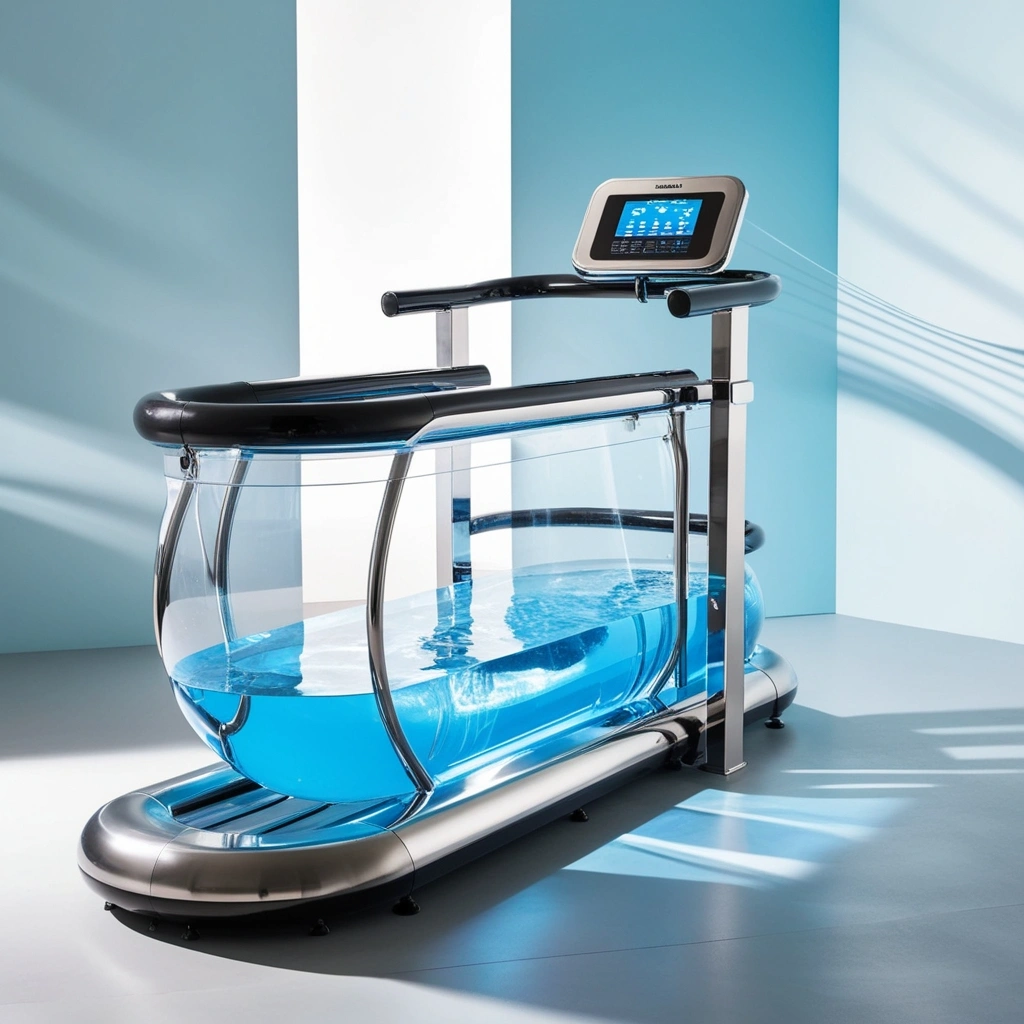
Components of a Water Treadmill
Treadmill Belt: Water treadmills are like Traditional Treadmills. They have a moving belt. Users walk, jog, or run on it.
Water Tank: Beneath the treadmill belt lies a tank filled with water. The depth of the water can typically be adjusted to customize the level of resistance.
Control Panel: Most water treadmills have a control panel. It lets users adjust speed, incline (if applicable), and other settings.
Safety Features: To ensure safe usage, water treadmills may have handrails. They also have emergency stop buttons and non-slip surfaces.
Different Designs Available in the Market
In-Ground Treadmills: These treadmills are installed on the floor. The water tank is flush with the ground. They offer a sleek and integrated design suitable for professional facilities.
Above-Ground Treadmills: These treadmills have a visible water tank under the treadmill belt. They are often more portable and easier to install than in-ground models. They come in many sizes and shapes. They fit different spaces and user needs.
Aquatic Therapy Pools: You’re right! Some water treadmills are like little rivers inside bigger pools. These bigger pools can have fancy showers. The showers massage your muscles. They have currents that make it hard to walk against, like a strong river.
Users who grasp water treadmill operations can make informed choices. They can choose when to use and buy them. This applies to rehab, fitness, or sports.
Benefits of Water Treadmill
Water treadmills offer many benefits. They make a valuable tool for rehab, fitness, and well-being. Let’s explore some of the key advantages:
Rehabilitation Benefits for Injury Recovery
Low-Impact Exercise: Water treadmills are low-impact. They reduce stress on joints. This makes them ideal for people recovering from injuries or surgeries. These injuries often affect the knees, hips, or ankles.
Enhanced Range of Motion: The buoyancy of water supports the body. It allows for gentle stretching and movement. This promotes flexibility and improves the range of motion. It does so without worsening existing injuries.
Improved Balance and Stability: Water’s resistance challenges muscles but doesn’t strain them. It helps improve balance and stability. These are key for preventing falls and re-injury during rehab.
Gradual Progression
Water treadmills are great for getting back in shape after an injury. They’re easy on your body because the water holds you up, so your joints don’t get banged around. You can start slow and easy, then walk for longer or harder as you get stronger.
Exercise Advantages for Fitness
Joint Protection: Water treadmills are like magic carpets for your joints! The water holds you up, so there’s no hard pounding on your knees or hips. This makes them great for people with arthritis, weak bones, or other joint ouchies.
Reduced Muscle Soreness: Water provides resistance. It makes muscles work without the strain of land exercises. This leads to less soreness and faster recovery.
Calorie Burn and Weight Management
Water treadmill workouts are low-impact. But, they can still burn calories well. So, they are a valuable tool for weight management and fitness.
Variety and Fun: Water treadmill workouts offer a refreshing change from land-based exercises. They add variety and fun to fitness routines. They might also motivate people to exercise more.
Improvement in Cardiovascular Health and Muscle Strength
Cardiovascular Conditioning: Water treadmill workouts raise heart rate. They give heart benefits like land-based exercises do. They improve overall heart health and endurance.
Muscle Strength and Endurance: Water’s resistance challenges muscles throughout the body. This includes muscles in the legs, core, and arms. It leads to gains in muscle strength, endurance, and tone.
Whole-Body Workout: Water treadmill workouts engage many muscle groups at once. They provide a full, whole-body workout. This targets both large and small muscles.
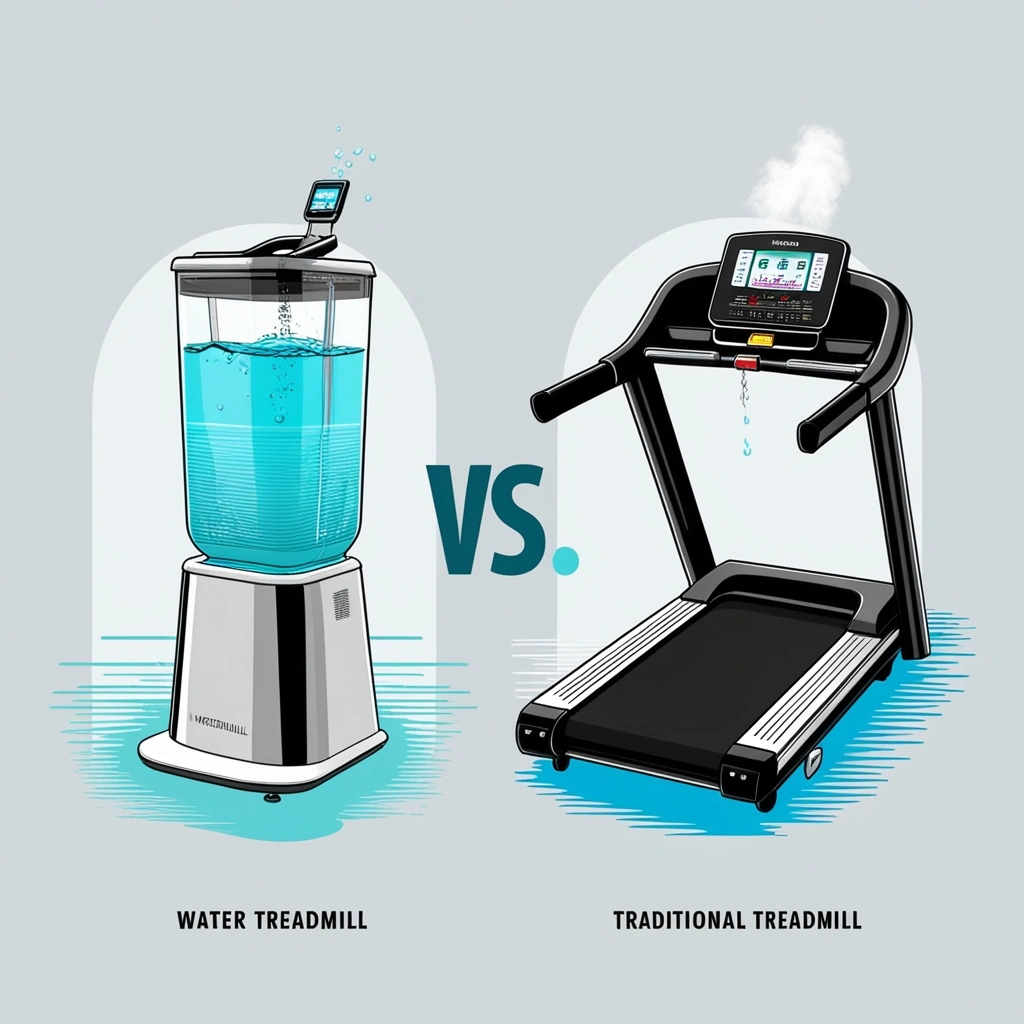
Water Treadmill vs. Traditional Treadmill
Water treadmills are different from regular ones. Regular treadmills can hurt your knees and ankles. Water treadmills feel like a boat in the pool, softer on your body.
They both burn calories, but water might make you work harder because it pushes you back. Water treadmills are the best for getting better after an injury. They are gentle and let you slowly ease into exercise. Let’s delve into these aspects:
Comparison of Impact on Joints
Traditional Treadmill: Traditional treadmills provide a solid surface for running or walking. This can lead to a big impact on joints, especially the knees, hips, and ankles. The pounding motion repeats. It can make existing joint issues worse and raise the injury risk. This is especially true for people with conditions like arthritis or joint pain.
Water Treadmill: Water treadmills offer a buoyant environment that reduces the impact on joints. The water resists the body. This cushions it, making water exercise low-impact. It is good for people with joint pain or recovering from injuries. The buoyancy of water supports the body’s weight. It reduces strain on joints but still provides an effective workout.
Efficiency in Burning Calories
Traditional Treadmill: Traditional treadmills provide a simple way to burn calories. The user’s effort moves them forward. The calorie-burning potential varies. It depends on factors like speed, incline, and duration of the workout.
Water Treadmill: Water treadmill workouts may not feel as intense as land-based ones. But, they still offer an effective calorie-burning workout. The water provides resistance. It requires more effort from muscles. This leads to burning more calories. In addition, water treadmill workouts engage more muscles. This helps to burn more calories.
Effectiveness in Rehabilitation
Traditional Treadmill: Traditional treadmills are not made for rehab. They provide a high-impact workout. This may not be good for people recovering from injuries or surgeries. However, they can still be used for rehab. This is possible under supervision and with changes to reduce impact.
Water Treadmill: Water treadmills are widely recognized for their effectiveness in rehabilitation. Water treadmills are great for people healing from broken bones. They also help those with joint surgery or sore joints, like arthritis. They’re gentler than regular treadmills because the water holds you up. This lets you move more easily. You can stretch further and build muscle without hurting yourself more.
Safety Measures and Precautions
Ensuring safety during water treadmill usage is paramount to prevent accidents and injuries. Here are some key safety measures and precautions to consider:
Importance of Supervision, Especially for Beginners
If you’re new to water treadmills, it’s best to have someone who knows what they’re doing show you the ropes first. They can help you stay safe and get the most out of your workout.
Supervision helps ensure proper form and technique. It reduces the risk of overexertion or misuse. It also provides help in emergencies.
Risk of Drowning and Safety Features
The risk of drowning on a water treadmill is minimal, especially with supervision. But, users should still be cautious. This is especially true if they are not comfortable in water. It should have safety features.
These include emergency stop buttons, handrails for support, and non-slip surfaces. They must be present and work on the water treadmill. Users should be told how to use these safety features. They should learn emergency procedures before starting a workout.
Guidelines for Usage, Including Weight Limits and Age Restrictions
Water treadmills have weight limits, just like anything else. You must follow these limits for two reasons. First, to keep the machine from breaking. Second, to keep you safe.
Age restrictions may apply. This is especially true for children or people with certain medical conditions. Water treadmills are great, but there are a few things to remember. If you’re new to them, it’s smart to ask someone who knows how to use them to show you around first.
Water treadmills also have weight limits, just like a swing set. Make sure you’re under the limit to keep yourself safe and the machine from breaking. And lastly, if you have any health problems already talk to your doctor before you try a water treadmill. They can tell you if it’s a good idea for you.
Each water treadmill is different. So, it’s important to read the instructions before you jump in. The instructions will tell you things like how much water to add. They will also cover how to start and stop the treadmill safely and how to stand for the best workout.
You should include warm-up and cool-down periods in water treadmill workouts. They prepare the body for exercise and aid in recovery. By following these safety measures, users can enjoy water treadmill workouts.
They also minimize the risk of accidents or injuries. Remember, safety should always be a priority. If in doubt, ask a qualified instructor or healthcare professional for help.
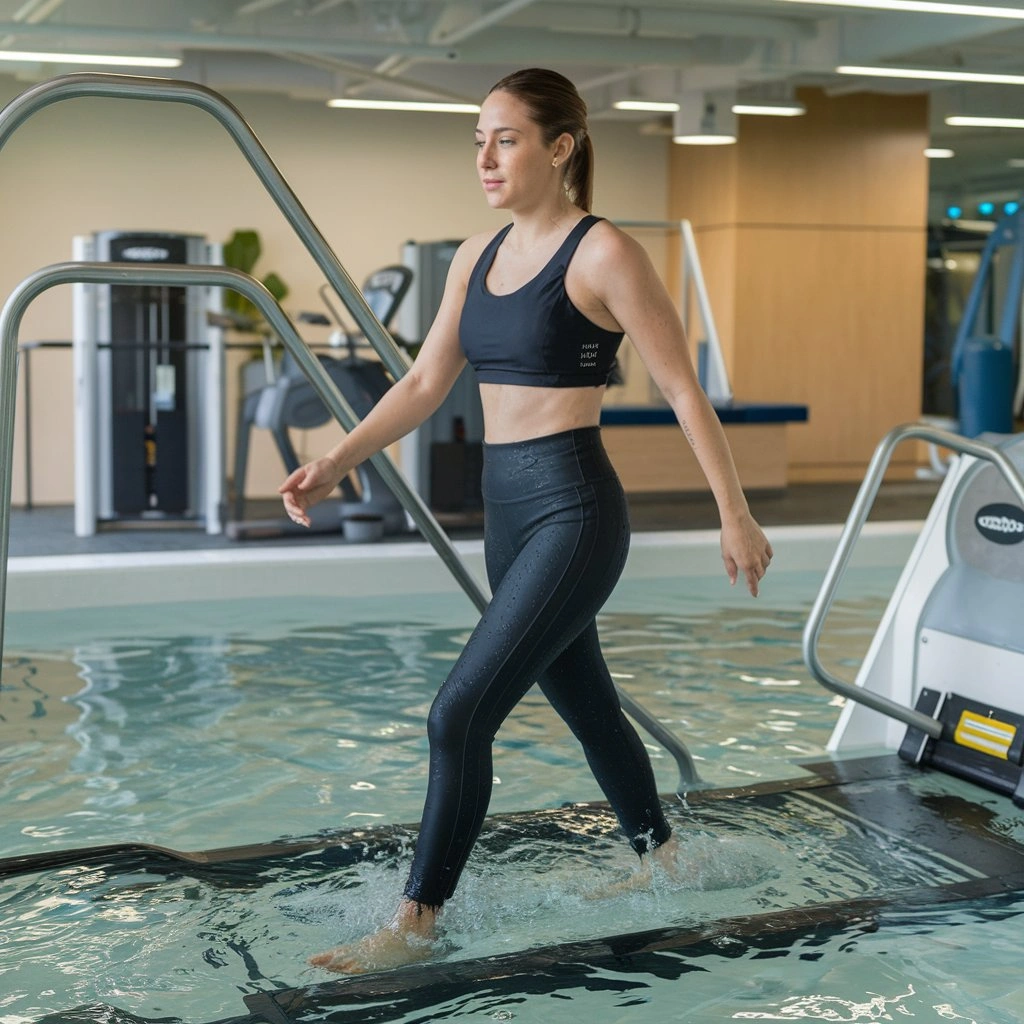
Choosing the Right Water Treadmill
Choosing the right water treadmill considers many factors. You want to make sure it meets your needs and preferences. Here are some key aspects to consider before making a purchase:
Factors to Consider Before Purchasing
Use it to determine if the water treadmill is for rehab, fitness, or both. Different models may offer features tailored to specific purposes.
Size and space: Assess the available space. It is where the water treadmill will be installed. Consider the size of the treadmill. Make sure it fits well in the designated area.
Adjustability: Look for a water treadmill with adjustable water levels and resistance settings. This allows for customization of workouts. They can fit different fitness levels and rehab needs.
Durability and Build Quality: Invest in a water treadmill. It is made from high-quality materials. It can withstand regular use and last a long time. Check for features such as sturdy construction and corrosion-resistant components.
Ease of Maintenance: Consider the ease of cleaning and maintaining the water treadmill. Look for models with easy-to-reach parts. They have simple maintenance needs. This cuts downtime and upkeep costs.
Additional Features: Some water treadmills have extras. These include little screens. The screens show how long you’ve been working out, how far you’ve gone, and how many calories you’ve burned. They might also have speakers built in, so you can listen to music while you walk.
Some even work with fitness trackers you wear, so all your exercise info goes in one place. These extras are cool, but pick the ones you want. Do you like seeing your workout numbers? Would music make it more fun? Do you use a fitness tracker already? Only get the extras you’ll use!
Warranty and Customer Support: Review the warranty from the manufacturer. Ask about customer support. A full warranty and helpful customer service can bring peace of mind. They also help with issues.
Budget Considerations
Set a budget based on your financial limits. Also, consider the features you want in a water treadmill. Water treadmills come in fancy and plain versions. Fancy ones might have cool extras and last longer. But, plain ones can still give you a great workout and help you heal after an injury. Pick the one that fits your wallet!
Consider the long-term cost of ownership. This cost includes maintenance and repairs. Consider these costs when budgeting for a water treadmill.
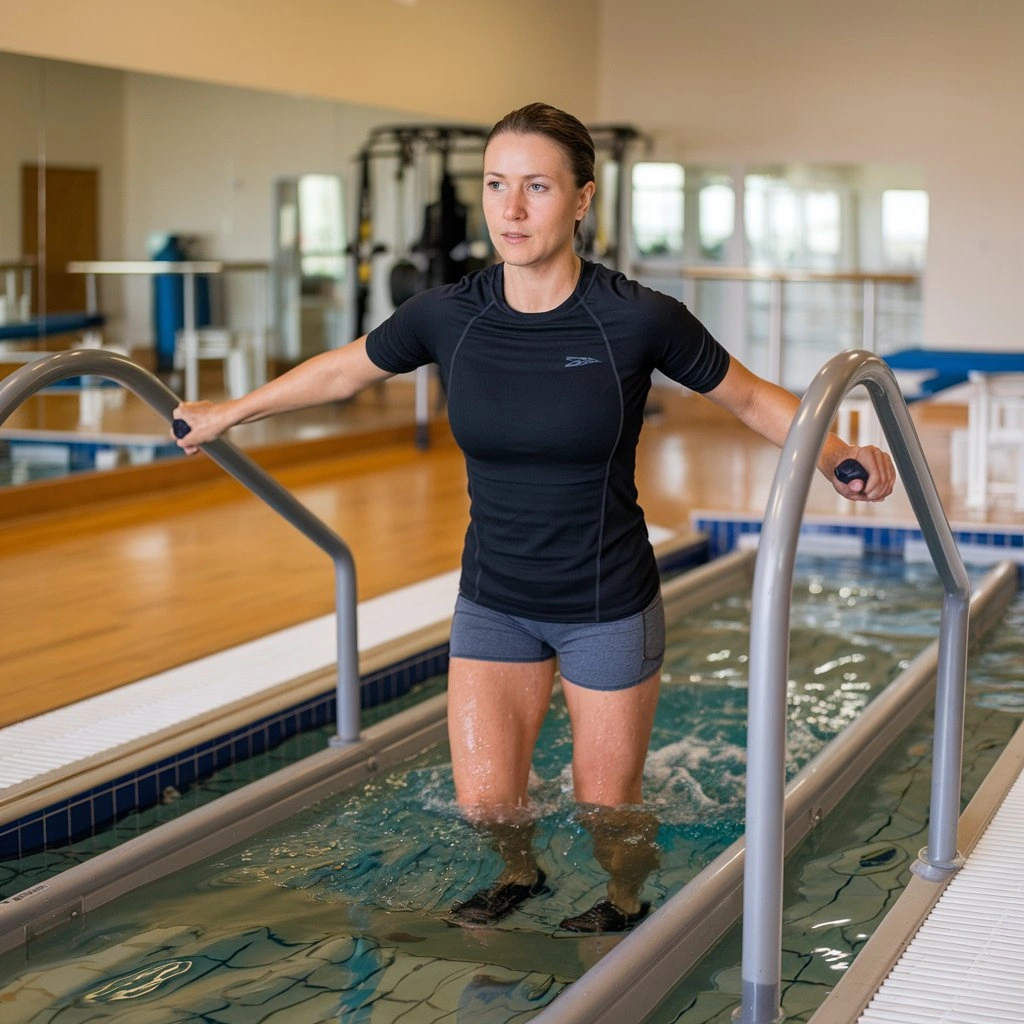
Reviews and Recommendations
Before you take the plunge (literally!), it’s smart to do your homework on water treadmills. Read what other people say about them online. Look for reviews from regular people who’ve used them. Also, look for reviews from trainers who know their stuff and from trusted websites. This will help you figure out which ones work well and last a long time.
Water treadmills are awesome, but before you jump in one, it’s a good idea to talk to someone who knows a lot about them. Ask your doctor, a physical therapist, or a trainer who works with people who use water treadmills. They can tell you if a water treadmill is right for you and which might be the best choice.
Water treadmills come in all shapes and sizes. Before you pick one, it’s best to try them out first. Head to a sports store that sells them or see if there’s a fitness show happening nearby. That way, you can climb on and see how they feel. This will help you pick the perfect one for you!
Setting Up and Maintenance
Proper installation and regular maintenance are vital. They ensure the long life and top performance of a water treadmill. Here’s a guide to setting up, maintaining, and troubleshooting common issues:
Installation Process
Choose the Location: Pick a good spot for the water treadmill. It should have enough space and access to water and power. Prepare the Site: Clear the area of any debris or obstacles and ensure the floor is level and stable.
Assemble the Water Treadmill
Once you’ve picked your water treadmill, it’s time to put it together. Each water treadmill is a bit different. So, read the instructions carefully before you start. The instructions will tell you how to put the pieces together and make sure they fit well.
Connect Utilities
Connect the water supply and electrical parts per the manufacturer’s specs. Make sure all connections are secure and well-insulated.
Test Operation: Test the water treadmill. Make sure all functions work. Adjust settings as needed.
Maintenance Requirements
Regular Cleaning
Clean the water treadmill regularly to remove dirt, debris, and sweat buildup. Use mild soap and water to wipe surfaces. Avoid abrasive cleaners. They could damage the equipment.
Water Treatment: Monitor water quality. Treat the water as needed to prevent algae and keep it clear. Follow the manufacturer’s recommendations for water treatment products and dosages.
Inspect Components: Inspect the treadmill belt, rollers, and motor often. Also, check other parts for signs of wear or damage. Replace any worn or damaged parts promptly to prevent further issues.
Lubrication: Put oil on moving parts, like the treadmill belt and rollers. Do this as the maker recommends. It keeps them smooth and prevents too much wear.
Check Safety Features: Test safety features often. These include emergency stop buttons and handrails. Test them to ensure they work and are accessible in an emergency.
Troubleshooting Common Issues
Water Leaks: Check for leaks in the water tank or plumbing connections. Tighten fittings or replace seals as needed to prevent leaks.
Motor Malfunction: If the treadmill motor is not working. Check for loose or damaged wiring. If the motor needs replacement, contact the maker. Or, ask a qualified technician for help.
Belt Slippage
If the treadmill belt slips during operation, check for proper tension and alignment. Adjust the tension and alignment as needed according to the manufacturer’s instructions.
Electrical Issues
If the treadmill does not power on or has electrical problems, check the power supply. Also, check the connections. Make sure the power cord is plugged in securely. Also, check for tripped circuit breakers or blown fuses.
Uneven Water Level
If the water level in the tank is uneven, adjust the leveling feet or add water to achieve the desired level. Ensure the tank is filled evenly to prevent imbalance and instability during use.
Workout Routines on a Water Treadmill
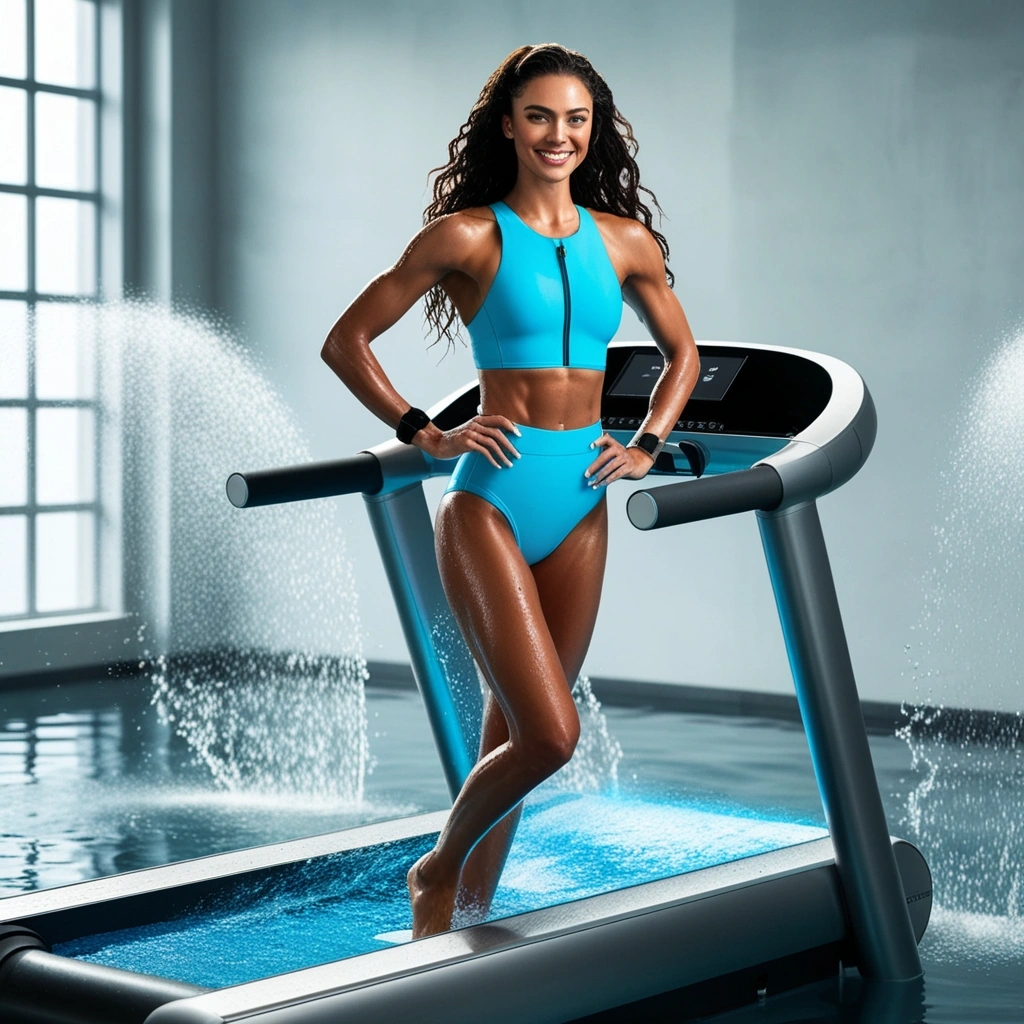
Water treadmills offer a versatile platform. They work for many workout routines. They cater to people of all fitness levels and goals. Here’s a guide to structuring a full water treadmill workout. It covers warm-ups, cardio, strength exercises, and cool-downs.
Warm-Up Exercises
Walking or Jogging
Begin your warm-up by walking or jogging at a comfortable pace on the water treadmill. Focus on keeping proper form and posture. Gradually increase your speed and range of motion.
Dynamic Stretches: Incorporate dynamic stretches to warm up your muscles and joints further. Do arm swings, leg swings, and torso twists. They will improve flexibility and mobility.
Cardiovascular Workouts
Interval Training
Go hard, then rest, go hard, then rest. This keeps your heart working hard and helps you last longer. For example, alternate between sprinting and walking or jogging at a moderate pace.
Resistance Training
Make your workout harder by
Adding more water: The higher the water, the harder it is to move your legs.
Going faster: Walk or jog quicker to get your heart pumping more. Focus on maintaining proper form and breathing throughout the workout.
Incline Training
If your water treadmill has a fancy tilt setting, use it sometimes! It makes you feel like you’re walking uphill, which works your heart even harder. Strength Training Exercises:
Aquatic Resistance Exercises
The water pushes back when you move, so you can use it to do exercises that build muscle! You can work your arms, legs, and even your core by moving against the water. Examples include:
Leg Press
Hold onto the bars and kick your legs back and forth, like you’re pushing a heavyweight machine at the gym, but with the water pushing back instead.
Bicep Curls
Hold onto the handrails and perform bicep curls by bending your elbows and lifting your hands toward your shoulders against the resistance of the water.
Squats: Stand with your feet hip-width apart and squat down, lowering your body into the water. Push through your heels to return to the starting position.
Upper Body Exercises
Incorporate exercises such as arm circles, shoulder presses, and chest presses using the resistance of the water to strengthen your upper body muscles.
Cool-Down Routines
Slow Walking or Jogging
Gradually decrease the intensity of your workout by slowing down your pace and allowing your heart rate to return to its resting state.
Static Stretches
Perform static stretches to help relax and lengthen your muscles after your workout. Focus on stretching the major muscle groups used during your workout.
Deep Breathing
Finish your cool-down routine with deep breathing exercises to promote relaxation and recovery. Inhale deeply through your nose, hold for a few seconds, and exhale slowly through your mouth.
Conclusion
Water treadmills are a cool way to get in shape or heal after an injury. They’re gentler on your body than regular treadmills, but they can still give you a great workout. This guide showed you everything you need to know about water treadmills.
Now you’re ready to jump in (carefully!) and try one for yourself! Water treadmills are like fancy exercise machines that use water to help you work out. The water holds you up, makes you work harder when you move, and keeps you safe.
This makes them perfect for people of all ages and fitness levels. They’re great for healing after an injury, getting your heart healthy, or just trying a new way to exercise. Water treadmills help you burn calories, and can even help you get better after an injury.
Pretty neat, right? Water treadmills are awesome, but there are a few things to think about before you get one. You’ll need to figure out how to put it together, how to take care of it, and how to use it safely.
The instructions will tell you how to put it together, and there are some easy things you can do to keep it working well. you can make sure you have a fun and safe workout every time you use your water treadmill!
Water treadmills aren’t just for walking! You can do a whole workout on them, from warming up to cooling down. There are exercises to get your heart pumping, build muscle, and even stretch to finish. It’s like having a mini gym right in your pool!
Water treadmills rock! They’re a great way to work out without hurting your joints. They can help you heal after an injury, get your heart healthy, build muscle, and even stretch. It’s like having a mini gym in your pool! So, if you’re looking for a fun way to get in shape, a water treadmill might be the perfect fit for you!

